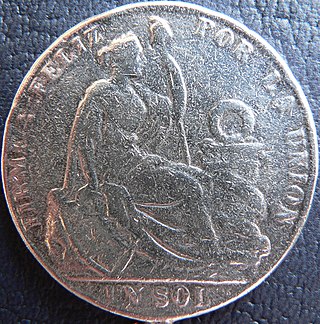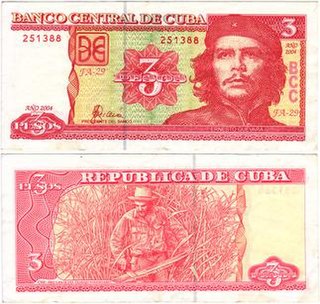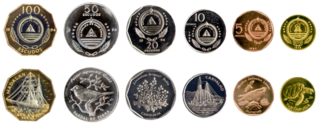
The Portuguese escudo was the currency of Portugal from 22 May 1911 until the introduction of the euro on 1 January 2002. The escudo was subdivided into 100 centavos. The word escudo derives from the scutum shield.

The Macanese pataca or Macau pataca is the currency of the Macao Special Administrative Region of the People's Republic of China. It is subdivided into 100 avos, with 10 avos called ho (毫) in Cantonese.

The córdoba is the currency of Nicaragua. It is divided into 100 centavos.

The Sucre was the currency of Ecuador between 1884 and 2000. Its ISO code was ECS and it was subdivided into 10 decimos and 100 centavos. The sucre was named after Latin American political leader Antonio José de Sucre. The currency was replaced by the United States dollar as a result of the 1998–99 financial crisis.

The sol, later sol de oro, was the currency of Peru between 1863 and 1985. It had the ISO 4217 currency code PES. It was subdivided into 10 dineros or 100 centavos. It also had two different superunits over its circulation life, the inca (1881–1882) and later the gold pound, both worth 10 soles.

The Colombian peso is the currency of Colombia. Its ISO 4217 code is COP. The official peso symbol is $, with Col$. also being used to distinguish it from other peso- and dollar-denominated currencies.
The kwanza is the currency of Angola. Four different currencies using the name kwanza have circulated since 1977. The currency derives its name from the Kwanza River.

The Cuban peso also known as moneda nacional, is the official currency of Cuba.
The colón is the currency of Costa Rica. It was named after Christopher Columbus, known as Cristóbal Colón in Spanish. A colón is divided into one hundred céntimos.
The colón was the currency of El Salvador from 1892 until 2001, when it was replaced by the U.S. dollar during the presidency of Francisco Flores. The colón was subdivided into 100 centavos and its ISO 4217 code was SVC. The plural is "colones" in Spanish and the currency was named after Christopher Columbus, known as Cristóbal Colón in Spanish.

The escudo is the currency of the Republic of Cape Verde. One escudo is subdivided into one hundred centavos.

The escudo was the currency of Portuguese India between 1958 and 1961. It was subdivided into 100 centavos and was equal in value to the Portuguese escudo. After Goa was invaded by the Republic of India in 1961, the escudo was replaced by the Indian rupee.
The peso was the currency of Paraguay between 1856 and 1944. It replaced the real at a rate of 8 reales = 1 peso. Until 1870, the peso was subdivided into 8 reales. Paraguay then decimalized, with 100 centésimos = 1 peso. The name of the subdivision was changed to centavo in 1874. The peso was replaced in 1944 by the guaraní at a rate of one hundred to one.

The escudo was the currency of São Tomé and Príncipe between 1914 and 1977. It was equivalent to the Portuguese escudo and subdivided into 100 centavos.

The escudo was the currency of Portuguese Timor between 1959 and 1976. It replaced the pataca at a rate of 5.6 escudos = 1 pataca and was equivalent to the Portuguese escudo. It was replaced by the Indonesian rupiah at an unknown exchange rate following East Timor's occupation by Indonesia. The escudo was subdivided into 100 centavos.
The angolar was the currency of Portuguese Angola between 1928 and 1958. It was subdivided into 100 centavos or 20 macutas. Angolar is Portuguese for "of Angola".
The peso was the currency of El Salvador between 1877 and 1919.
The pataca was a monetary unit of account used in Portuguese Timor between 1894 and 1958, except for the period 1942–1945, when the occupying Japanese forces introduced the Netherlands Indies gulden and the roepiah. As in the case of the Macanese pataca which is still in use today, the East Timor unit was based on the silver Mexican dollar coins which were prolific in the wider region in the 19th century. These Mexican dollar coins were in turn the lineal descendants of the Spanish pieces of eight which had been introduced to the region by the Portuguese through Portuguese Malacca, and by the Spanish through the Manila Galleon trade.
The escudo was the currency of Portuguese Guinea between 1914 and 1975. It was equal to the Portuguese escudo and replaced the real at a rate of 1000 réis = 1 escudo. The escudo was subdivided into 100 centavos. Portugal issued banknotes and coins for use in Portuguese Guinea. Following independence, the peso replaced the escudo at par.

The first boliviano was the currency of Bolivia from 1864 to 1963. Due to rising inflation, it was replaced with the peso boliviano at an exchange rate of 1000 bolivianos to 1 peso. The peso was later replaced by the second Bolivian boliviano.














